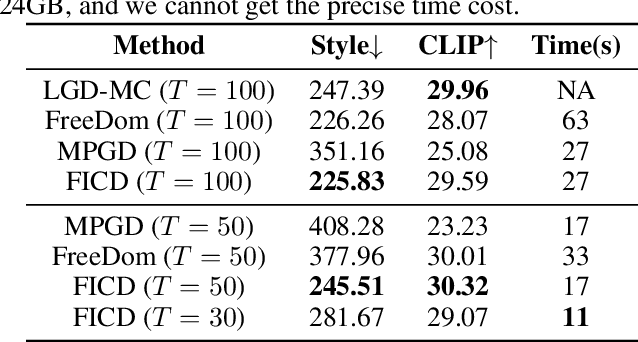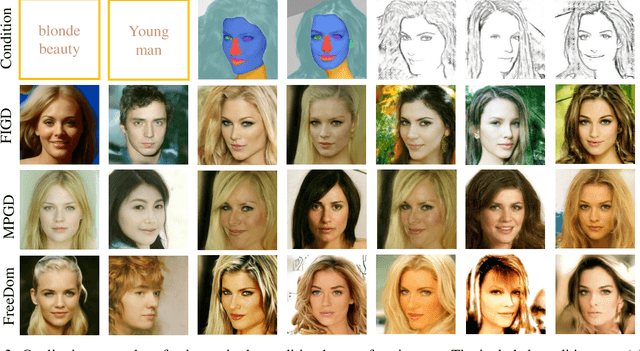Kaiyu Song
Rethinking Oversaturation in Classifier-Free Guidance via Low Frequency
Jun 26, 2025



Abstract:Classifier-free guidance (CFG) succeeds in condition diffusion models that use a guidance scale to balance the influence of conditional and unconditional terms. A high guidance scale is used to enhance the performance of the conditional term. However, the high guidance scale often results in oversaturation and unrealistic artifacts. In this paper, we introduce a new perspective based on low-frequency signals, identifying the accumulation of redundant information in these signals as the key factor behind oversaturation and unrealistic artifacts. Building on this insight, we propose low-frequency improved classifier-free guidance (LF-CFG) to mitigate these issues. Specifically, we introduce an adaptive threshold-based measurement to pinpoint the locations of redundant information. We determine a reasonable threshold by analyzing the change rate of low-frequency information between prior and current steps. We then apply a down-weight strategy to reduce the impact of redundant information in the low-frequency signals. Experimental results demonstrate that LF-CFG effectively alleviates oversaturation and unrealistic artifacts across various diffusion models, including Stable Diffusion-XL, Stable Diffusion 2.1, 3.0, 3.5, and SiT-XL.
Test-time Alignment-Enhanced Adapter for Vision-Language Models
Nov 24, 2024Abstract:Test-time adaptation with pre-trained vision-language models (VLMs) has attracted increasing attention for tackling the issue of distribution shift during the test phase. While prior methods have shown effectiveness in addressing distribution shift by adjusting classification logits, they are not optimal due to keeping text features unchanged. To address this issue, we introduce a new approach called Test-time Alignment-Enhanced Adapter (TAEA), which trains an adapter with test samples to adjust text features during the test phase. We can enhance the text-to-image alignment prediction by utilizing an adapter to adapt text features. Furthermore, we also propose to adopt the negative cache from TDA as enhancement module, which further improves the performance of TAEA. Our approach outperforms the state-of-the-art TTA method of pre-trained VLMs by an average of 0.75% on the out-of-distribution benchmark and 2.5% on the cross-domain benchmark, with an acceptable training time. Code will be available at https://github.com/BaoshunWq/clip-TAEA.
Enhancing Few-Shot Out-of-Distribution Detection with Gradient Aligned Context Optimization
Nov 24, 2024



Abstract:Few-shot out-of-distribution (OOD) detection aims to detect OOD images from unseen classes with only a few labeled in-distribution (ID) images. To detect OOD images and classify ID samples, prior methods have been proposed by regarding the background regions of ID samples as the OOD knowledge and performing OOD regularization and ID classification optimization. However, the gradient conflict still exists between ID classification optimization and OOD regularization caused by biased recognition. To address this issue, we present Gradient Aligned Context Optimization (GaCoOp) to mitigate this gradient conflict. Specifically, we decompose the optimization gradient to identify the scenario when the conflict occurs. Then we alleviate the conflict in inner ID samples and optimize the prompts via leveraging gradient projection. Extensive experiments over the large-scale ImageNet OOD detection benchmark demonstrate that our GaCoOp can effectively mitigate the conflict and achieve great performance. Code will be available at https://github.com/BaoshunWq/ood-GaCoOp.
Leveraging Previous Steps: A Training-free Fast Solver for Flow Diffusion
Nov 12, 2024



Abstract:Flow diffusion models (FDMs) have recently shown potential in generation tasks due to the high generation quality. However, the current ordinary differential equation (ODE) solver for FDMs, e.g., the Euler solver, still suffers from slow generation since ODE solvers need many number function evaluations (NFE) to keep high-quality generation. In this paper, we propose a novel training-free flow-solver to reduce NFE while maintaining high-quality generation. The key insight for the flow-solver is to leverage the previous steps to reduce the NFE, where a cache is created to reuse these results from the previous steps. Specifically, the Taylor expansion is first used to approximate the ODE. To calculate the high-order derivatives of Taylor expansion, the flow-solver proposes to use the previous steps and a polynomial interpolation to approximate it, where the number of orders we could approximate equals the number of previous steps we cached. We also prove that the flow-solver has a more minor approximation error and faster generation speed. Experimental results on the CIFAR-10, CelebA-HQ, LSUN-Bedroom, LSUN-Church, ImageNet, and real text-to-image generation prove the efficiency of the flow-solver. Specifically, the flow-solver improves the FID-30K from 13.79 to 6.75, from 46.64 to 19.49 with $\text{NFE}=10$ on CIFAR-10 and LSUN-Church, respectively.
Unraveling the Connections between Flow Matching and Diffusion Probabilistic Models in Training-free Conditional Generation
Nov 12, 2024



Abstract:Training-free conditional generation aims to leverage the unconditional diffusion models to implement the conditional generation, where flow-matching (FM) and diffusion probabilistic models (DPMs) are two mature unconditional diffusion models that achieve high-quality generation. Two questions were asked in this paper: What are the underlying connections between FM and DPMs in training-free conditional generation? Can we leverage DPMs to improve the training-free conditional generation for FM? We first show that a probabilistic diffusion path can be associated with the FM and DPMs. Then, we reformulate the ordinary differential equation (ODE) of FM based on the score function of DPMs, and thus, the conditions in FM can be incorporated as those in DPMs. Finally, we propose two posterior sampling methods to estimate the conditional term and achieve a training-free conditional generation of FM. Experimental results show that our proposed method could be implemented for various conditional generation tasks. Our method can generate higher-quality results than the state-of-the-art methods.
Fisher Information Improved Training-Free Conditional Diffusion Model
Apr 28, 2024



Abstract:Recently, the diffusion model with the training-free methods has succeeded in conditional image generation tasks. However, there is an efficiency problem because it requires calculating the gradient with high computational cost, and previous methods make strong assumptions to solve it, sacrificing generalization. In this work, we propose the Fisher information guided diffusion model (FIGD). Concretely, we introduce the Fisher information to estimate the gradient without making any additional assumptions to reduce computation cost. Meanwhile, we demonstrate that the Fisher information ensures the generalization of FIGD and provides new insights for training-free methods based on the information theory. The experimental results demonstrate that FIGD could achieve different conditional generations more quickly while maintaining high quality.
Target to Source: Guidance-Based Diffusion Model for Test-Time Adaptation
Dec 08, 2023



Abstract:Most recent works of test-time adaptation (TTA) aim to alleviate domain shift problems by re-training source classifiers in each domain. On the other hand, the emergence of the diffusion model provides another solution to TTA, which directly maps the test data from the target domain to the source domain based on a diffusion model pre-trained in the source domain. The source classifier does not need to be fine-tuned. However, 1) the semantic information loss from test data to the source domain and 2) the model shift between the source classifier and diffusion model would prevent the diffusion model from mapping the test data back to the source domain correctly. In this paper, we propose a novel guidance-based diffusion-driven adaptation (GDDA) to overcome the data shift and let the diffusion model find a better way to go back to the source. Concretely, we first propose detail and global guidance to better keep the common semantics of the test and source data. The two guidance include a contrastive loss and mean squared error to alleviate the information loss by fully exploring the diffusion model and the test data. Meanwhile, we propose a classifier-aware guidance to reduce the bias caused by the model shift, which can incorporate the source classifier's information into the generation process of the diffusion model. Extensive experiments on three image datasets with three classifier backbones demonstrate that GDDA significantly performs better than the state-of-the-art baselines. On CIFAR-10C, CIFAR-100C, and ImageNetC, GDDA achieves 11.54\%, 19.05\%, and 11.63\% average accuracy improvements, respectively. GDDA even achieves equal performance compared with methods of re-training classifiers. The code is available in the supplementary material.
MimicDiffusion: Purifying Adversarial Perturbation via Mimicking Clean Diffusion Model
Dec 08, 2023



Abstract:Deep neural networks (DNNs) are vulnerable to adversarial perturbation, where an imperceptible perturbation is added to the image that can fool the DNNs. Diffusion-based adversarial purification focuses on using the diffusion model to generate a clean image against such adversarial attacks. Unfortunately, the generative process of the diffusion model is also inevitably affected by adversarial perturbation since the diffusion model is also a deep network where its input has adversarial perturbation. In this work, we propose MimicDiffusion, a new diffusion-based adversarial purification technique, that directly approximates the generative process of the diffusion model with the clean image as input. Concretely, we analyze the differences between the guided terms using the clean image and the adversarial sample. After that, we first implement MimicDiffusion based on Manhattan distance. Then, we propose two guidance to purify the adversarial perturbation and approximate the clean diffusion model. Extensive experiments on three image datasets including CIFAR-10, CIFAR-100, and ImageNet with three classifier backbones including WideResNet-70-16, WideResNet-28-10, and ResNet50 demonstrate that MimicDiffusion significantly performs better than the state-of-the-art baselines. On CIFAR-10, CIFAR-100, and ImageNet, it achieves 92.67\%, 61.35\%, and 61.53\% average robust accuracy, which are 18.49\%, 13.23\%, and 17.64\% higher, respectively. The code is available in the supplementary material.
 Add to Chrome
Add to Chrome Add to Firefox
Add to Firefox Add to Edge
Add to Edge